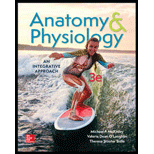
Which of the following is the correct circulatory sequence for blood to pass through part of the heart?
- a. right atrium → left AV valve → right ventricle → pulmonary semilunar valve
- b. right atrium → right AV valve → right ventricle → pulmonary semilunar valve
- c. left atrium → right AV valve → left ventricle → aortic semilunar valve
- d. left atrium → left AV valve → left ventricle → pulmonary semilunar valve
Introduction:
Homeostasis is maintained by continuous circulation of the blood in the body. Heart and blood vessels combine to make the cardiovascular system, where the circulation of blood takes place. The heart and blood vessels are organized into two types of circuits: the pulmonary circulation and systematic circulation.
Answer to Problem 1DYB
Correct answer:
The correct circulatory sequence for blood to pass through part of the heart is right atrium
Therefore, option (b) is correct.
Explanation of Solution
Reason for the correct statement:
Option (b) is given as “right atrium
Hence, option (b) is correct.
Reasons for incorrect statements:
Option (a) is given as “right atrium
The blood of the right atrium is present on the right side of the heart, thus, it travels from the right, but not the left, AV valve. Hence, it is not correct.
Option (c) is given as “left atrium
The blood from the left atrium is present on the left part of the heart, thus, it moves from the left, but not the right, AV valve. Hence, it is not correct.
Option (d) is given as “left atrium
The blood from the left ventricles travels form the aortic, but not pulmonary, semilumnar valve. Hence, it is not correct.
Hence, options (a), (c), and (d), are incorrect.
Blood flows from the right side of the heart to the lungs to systematic cells of body and then back to the right side.
Want to see more full solutions like this?
Chapter 19 Solutions
Anatomy and Physiology: An Integrative Approach with Connect Access Card
- Noggin mutation: The mouse, one of the phenotypic consequences of Noggin mutationis mispatterning of the spinal cord, in the posterior region of the mouse embryo, suchthat in the hindlimb region the more ventral fates are lost, and the dorsal Pax3 domain isexpanded. (this experiment is not in the lectures).a. Hypothesis for why: What would be your hypothesis for why the ventral fatesare lost and dorsal fates expanded? Include in your answer the words notochord,BMP, SHH and either (or both of) surface ectoderm or lateral plate mesodermarrow_forwardNot part of a graded assignment, from a past midtermarrow_forwardNot part of a graded assignment, from a past midtermarrow_forward
- please helparrow_forwardWhat does the heavy dark line along collecting duct tell us about water reabsorption in this individual at this time? What does the heavy dark line along collecting duct tell us about ADH secretion in this individual at this time?arrow_forwardBiology grade 10 study guidearrow_forward
 Human Physiology: From Cells to Systems (MindTap ...BiologyISBN:9781285866932Author:Lauralee SherwoodPublisher:Cengage Learning
Human Physiology: From Cells to Systems (MindTap ...BiologyISBN:9781285866932Author:Lauralee SherwoodPublisher:Cengage Learning Medical Terminology for Health Professions, Spira...Health & NutritionISBN:9781305634350Author:Ann Ehrlich, Carol L. Schroeder, Laura Ehrlich, Katrina A. SchroederPublisher:Cengage Learning
Medical Terminology for Health Professions, Spira...Health & NutritionISBN:9781305634350Author:Ann Ehrlich, Carol L. Schroeder, Laura Ehrlich, Katrina A. SchroederPublisher:Cengage Learning
 Biology (MindTap Course List)BiologyISBN:9781337392938Author:Eldra Solomon, Charles Martin, Diana W. Martin, Linda R. BergPublisher:Cengage Learning
Biology (MindTap Course List)BiologyISBN:9781337392938Author:Eldra Solomon, Charles Martin, Diana W. Martin, Linda R. BergPublisher:Cengage Learning





